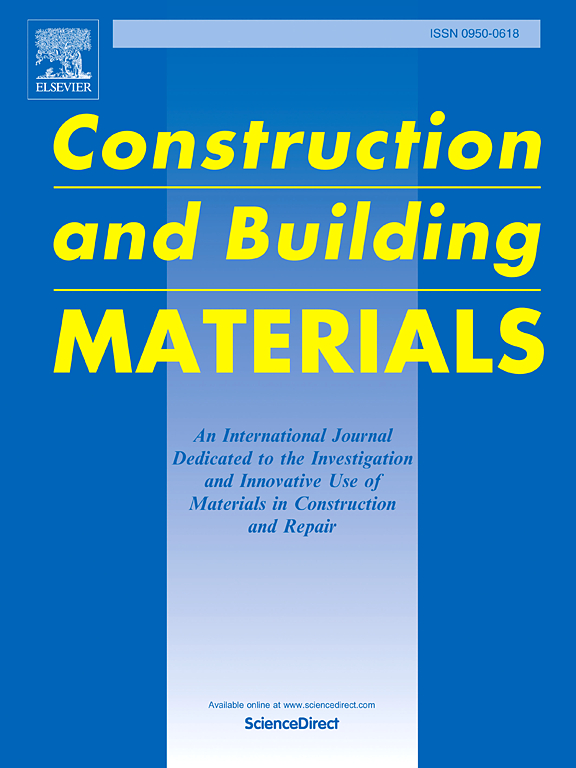Study on the mechanical properties of cementitious materials affected by the interactions between crystal and gel products driven by crystallization pressure
IF 7.4
1区 工程技术
Q1 CONSTRUCTION & BUILDING TECHNOLOGY
引用次数: 0
Abstract
Existing research on the mechanisms affecting the strength of cementitious materials primarily focuses on the composition and properties of cement hydration products, often overlooking the interactions between different products. This study presents a systematic experimental and theoretical investigation into the mechanical properties of cementitious materials, emphasizing the interactions between crystal and gel products driven by crystallization pressure. A new mechanism based on crystallization pressure is proposed to explain the impact of the interactions between hydration products on the strengths of cementitious materials. Experiments were conducted by immersing specimens in solutions with tailored ion concentrations (including water, isopropyl alcohol, ethanol, and solutions of calcium hydroxide and calcium acetate) to vary the crystallization pressure. The flexural and compressive strengths of these specimens were then tested. An analytical model was developed and validated against the experimental data. Both experimental and calculated results demonstrate a negative correlation between crystallization pressure and strength. Specimens subjected to crystallization pressures of 101.7 MPa and 147.8 MPa showed reductions in flexural strength of 19.34 % and 30.65 %, respectively, and decreases in compressive strength of 10.00 % and 14.41 %, compared to control specimens with zero crystallization pressure. These results suggest that ion concentrations in the pore solution alter the crystallization pressure, which in turn affects the interactions between crystal and gel products and strength of cementitious materials. This study provides insights into the mechanisms of strength degradation due to moisture in porous materials.
结晶压力驱动下结晶与凝胶产物相互作用对胶凝材料力学性能影响的研究
现有的影响胶凝材料强度的机理研究主要集中在水泥水化产物的组成和性能上,往往忽略了不同产物之间的相互作用。本研究对胶凝材料的力学性能进行了系统的实验和理论研究,强调了结晶压力驱动下晶体和凝胶产物之间的相互作用。提出了一种基于结晶压力的新机制来解释水化产物之间的相互作用对胶凝材料强度的影响。实验通过将样品浸泡在特定离子浓度的溶液中(包括水、异丙醇、乙醇、氢氧化钙和醋酸钙溶液)来改变结晶压力。然后测试了这些试件的抗折和抗压强度。建立了分析模型,并根据实验数据进行了验证。实验和计算结果均表明结晶压力与强度呈负相关。在101.7 MPa和147.8 MPa的结晶压力下,与零结晶压力下的对照试样相比,试件的抗折强度分别降低了19.34 %和30.65 %,抗压强度降低了10.00 %和14.41 %。这些结果表明,孔隙溶液中的离子浓度改变了结晶压力,从而影响了晶体和凝胶产物之间的相互作用以及胶凝材料的强度。本研究对多孔材料中受水分影响的强度退化机制提供了深入的见解。
本文章由计算机程序翻译,如有差异,请以英文原文为准。
求助全文
约1分钟内获得全文
求助全文
来源期刊

Construction and Building Materials
工程技术-材料科学:综合
CiteScore
13.80
自引率
21.60%
发文量
3632
审稿时长
82 days
期刊介绍:
Construction and Building Materials offers an international platform for sharing innovative and original research and development in the realm of construction and building materials, along with their practical applications in new projects and repair practices. The journal publishes a diverse array of pioneering research and application papers, detailing laboratory investigations and, to a limited extent, numerical analyses or reports on full-scale projects. Multi-part papers are discouraged.
Additionally, Construction and Building Materials features comprehensive case studies and insightful review articles that contribute to new insights in the field. Our focus is on papers related to construction materials, excluding those on structural engineering, geotechnics, and unbound highway layers. Covered materials and technologies encompass cement, concrete reinforcement, bricks and mortars, additives, corrosion technology, ceramics, timber, steel, polymers, glass fibers, recycled materials, bamboo, rammed earth, non-conventional building materials, bituminous materials, and applications in railway materials.
 求助内容:
求助内容: 应助结果提醒方式:
应助结果提醒方式:


